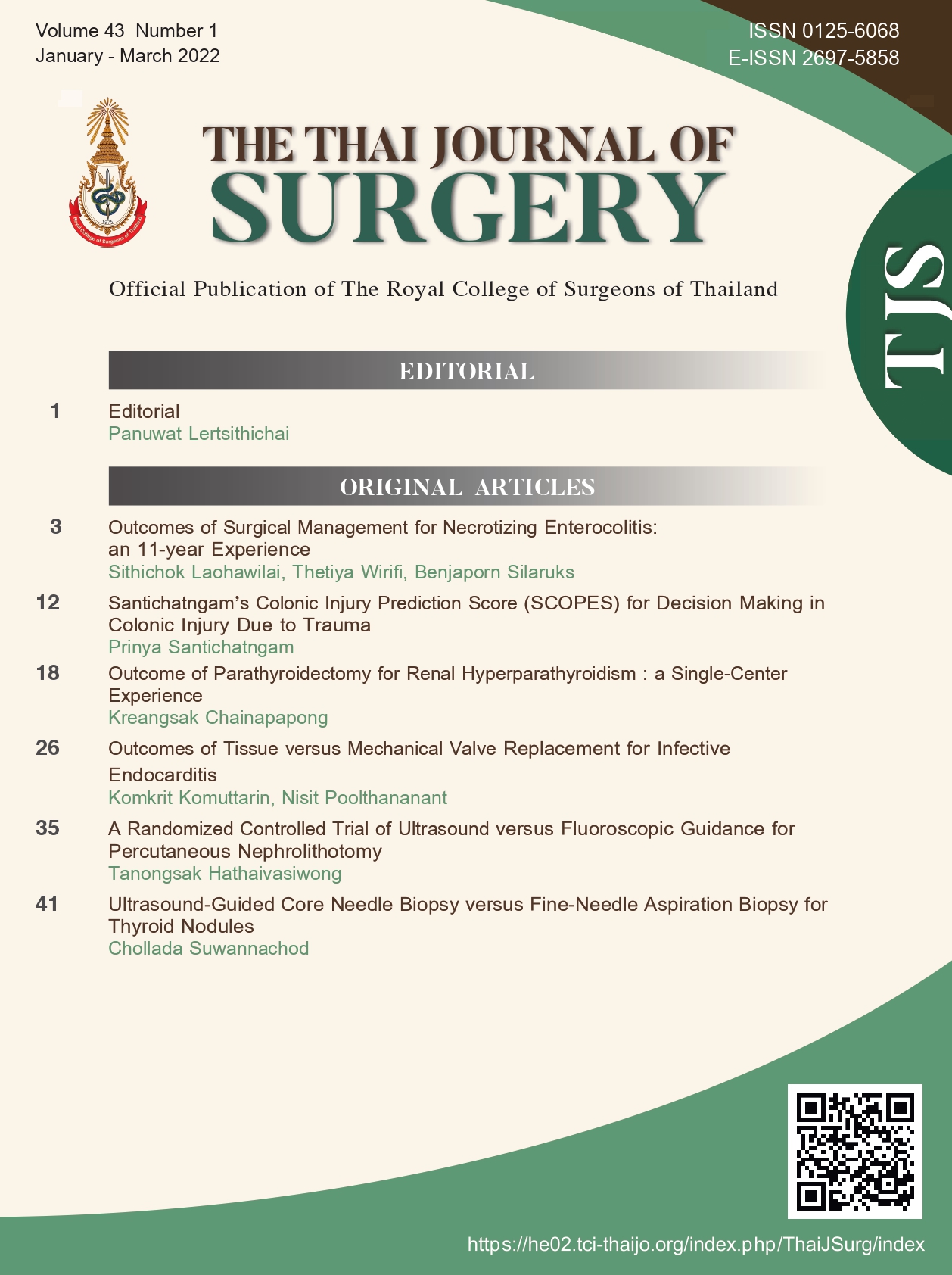A Randomized Controlled Trial of Ultrasound versus Fluoroscopic Guidance for Percutaneous Nephrolithotomy
Keywords:
Ultrasound, Fluoroscopic Guidance, Percutaneous NephrolithotomyAbstract
Objective: To compare the success rate of ultrasound (US) versus fluoroscopic guidance in entering the target calyx from a proper entry site and in the direction of renal pelvis during percutaneous nephrolithotomy (PCNL), and to determine their relative advantages and disadvantages.
Methods: The present randomized controlled study was conducted between May 2020 and March 2021. Just before PCNL, patients were randomly assigned to undergo either US guidance access (group A) or fluoroscopic guidance access (group B). A needle placed on the patient’s flank in the prone position was used to identify the preselected target. The needle was advanced through a needle holder and helped guide percutaneous tract dilation. Data on patient characteristics, tract length, tract access time, and the stone free rate were collected for analysis. Data were analyzed using t-test, chi-square test and Fisher’s exact test.
Results: There were a total of 40 patients in the trial with 20 patients in each group. There were no statistically significant differences between patients in groups A and B in terms of age, gender, ASA status, BMI, stone size and stone location. The average length of the access tract was 7.7 cm in group A and 7.6 cm. in group B (p = 0.672). The tract access time was 15 minutes in group A and 13 minutes in group B (p = 0.288). The frequencies of location of the access tract at the upper pole in groups A and B were 11 and 12, respectively (p = 0.252). The stone free rate was 45% (9/20) in group A and 55% (11/20) in group B (p = 0.853).
Conclusions: The present study showed that PCNL under US guidance had similar success as PCNL under fluoroscopic guidance. US can be used as an alternative to fluoroscopy in PCNL. The present randomized trial might help convince some endourologists to use US rather than fluoroscopy in their management of renal stones, in order to minimize exposure to ionizing radiation.
References
Rao PN, Faulkner K, Sweeney JK, et al. Radiation dose to patient and staff during percutaneous nephrostolithotomy. Br J Urol 1987;59:508–12.
Basiri A, Ziaee SA, Nasseh H, et al. Totally ultrasonography-guided percutaneous nephrolithotomy in the flank position. J Endourol 2008;22:1453–7.
Desai M. Ultrasonography-guided punctures-with and without puncture guide. J Endourol 2009;23:1641–3.
Hosseini MM, Hassanpour A, Farzan R, et al. Ultrasonography-guided percutaneous nephrolithotomy. J Endourol 2009;23:603–7.
Basiri A, Mohammadi Sichani M, et al. X-ray-free percutaneous nephrolithotomy in supine position with ultrasound guidance. World J Urol 2010;28:239–44.
Agarwal M, Agrawal MS, Jaiswal A, et al. Safety and efficacy of ultrasonography as an adjunct to fluoroscopy for renal access in percutaneous nephrolithotomy (PCNL). BJU Int. 2011;108:1346–9.
Chi Q, Wang Y, Lu J, et al. Ultrasonography combined with fluoroscopy for percutaneous nephrolithotomy: an analysis based on seven years single center experiences. Urol J 2014;11:1216–21.
Baralo B, Samson P, Hoenig D, et al. Percutaneous kidney stone surgery and radiation exposure: a review. Asian J Urol 2020;7:10–7.
Altman DG. Practical statistics for medical research. London: Chapman & Hall, 1991.
Fernbach SK, Maizels M, Conway JJ. Ultrasound grading of hydronephrosis: introduction to the system used by the society for fetal urology. Pediatr Radiol 1993;23:478–80.
Faulkner K, Vañó E. Deterministic effects in interventional radiology. Radiat Prot Dosimetry 2001;94:95–8.
Wenzl TB. Increased brain cancer risk in physicians with high radiation exposure. Radiology 2005;235:709-11.
Linet MS, Freedman DM, Mohan AK, et al. Incidence of haematopoietic malignancies in US radiologic technologists. Occup Environ Med 2005;62:861–7.
Majidpour HS. Risk of radiation exposure during PCNL. Urol J 2010;7:87–9.
Westphalen AC, Hsia RY, Maselli JH, et al. Radiological imaging of patients with suspected urinary tract stones: national trends, diagnoses, and predictors. Acad Emerg Med 2011;18:699–707.
Nualyong C, Sathidmangkang S, Woranisarakul V, et al. Comparison of the outcomes for retrograde intrarenal surgery (RIRS) and percutaneous nephrolithotomy (PCNL) in the treatment of renal stones more than 2 centimeters. Thai J Urol 2019;40:9–14.
Lantz AG, O’Malley P, Ordon M, et al. Assessing radiation exposure during endoscopic-guided percutaneous nephrolithotomy. Can Urol Assoc J 2014;8:347–51.
Isac W, Rizkala E, Liu X, et al. Endoscopic-guided versus fluoroscopic-guided renal access for percutaneous nephrolithotomy: a comparative analysis. Urology 2013;81:251–6.
Beiko D, Razvi H, Bhojani N, et al. Techniques – Ultrasound-guided percutaneous nephro-lithotomy: how we do it. Can Urol Assoc J 2020;14:E104–10.
Andonian S, Scoffone CM, Louie MK, et al. Does imaging modality used for percutaneous renal access make a difference? a matched case analysis. J Endourol 2013;27:24–8.
Lojanapiwat B. The ideal puncture approach for PCNL: fluoroscopy, ultrasound or endoscopy? Indian J Urol 2013;29:208–13.
Li J, Xiao B, Hu W, et al. Complication and safety of ultrasound guided percutaneous nephrolithotomy in 8, 025 cases in China. Chin Med J 2014;127:4184–9.
Basiri A, Ziaee AM, Kianian HR, et al. Ultrasonographic versus fluoroscopic access for percutaneous nephrolithotomy: a randomized clinical trial. J Endourol 2008;22:281-4.
Osman M, Wendt-Nordahl G, Heger K, et al. Percutaneous nephrolithotomy with ultrasonography-guided renal access: experience from over 300 cases. BJU Int 2005;96:875-8.
Lojanapiwat B. The ideal puncture approach for PCNL: fluoroscopy, ultrasound or endoscopy? Indian J Urol 2013;29:208–13.
Basiri A, Mirjalili MA, Kardoust Parizi M, et al. Supplementary X-ray for ultrasound-guided percutaneous nephrolithotomy in supine position versus standard technique: a randomized controlled trial. Urol Int 2013;90:399–404.
Ng FC, Yam WL, Lim TY, et al. Ultrasound-guided percutaneous nephrolithotomy: advantages and limitations. Investig Clin Urol 2017;58:346-52.
Downloads
Published
How to Cite
Issue
Section
License
Copyright (c) 2022 The Royal College of Surgeons of Thailand

This work is licensed under a Creative Commons Attribution-NonCommercial-NoDerivatives 4.0 International License.
Articles must be contributed solely to The Thai Journal of Surgery and when published become the property of the Royal College of Surgeons of Thailand. The Royal College of Surgeons of Thailand reserves copyright on all published materials and such materials may not be reproduced in any form without the written permission.



